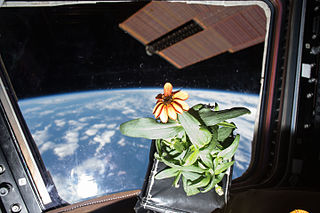
Hydroponics is a type of horticulture and a subset of hydroculture which involves growing plants, usually crops, without soil, by using water-based mineral nutrient solutions in aqueous solvents. Terrestrial or aquatic plants may grow with their roots exposed to the nutritious liquid or in addition, the roots may be mechanically supported by an inert medium such as perlite, gravel, or other substrates.
The following outline is provided as an overview of and topical guide to agriculture:

Agronomy is the science and technology of producing and using plants by agriculture for food, fuel, fiber, chemicals, recreation, or land conservation. Agronomy has come to include research of plant genetics, plant physiology, meteorology, and soil science. It is the application of a combination of sciences such as biology, chemistry, economics, ecology, earth science, and genetics. Professionals of agronomy are termed agronomists.
The following outline is provided as an overview of and topical guide to sustainable agriculture:

Utah State University is a public land-grant research university in Logan, Utah. It is accredited by the Northwest Commission on Colleges and Universities. With nearly 20,000 students living on or near campus, USU is Utah's largest public residential campus. As of Fall 2021, there were 27,426 students enrolled, including 24,255 undergraduate students and 3,171 graduate students. The university has the highest percentage of out-of-state students of any public university in Utah, totaling 23% of the student body.

Intercropping is a multiple cropping practice that involves growing two or more crops in proximity. In other words, intercropping is the cultivation of two or more crops simultaneously on the same field. The most common goal of intercropping is to produce a greater yield on a given piece of land by making use of resources or ecological processes that would otherwise not be utilized by a single crop.

Aquaponics is a food production system that couples aquaculture with the hydroponics whereby the nutrient-rich aquaculture water is fed to hydroponically grown plants, where nitrifying bacteria convert ammonia into nitrates.

Aeroponics is the process of growing plants in an air or mist environment without the use of soil or an aggregate medium. The word "aeroponic" is derived from the Greek meanings of aer ("air") and ponos ("labour"). It is a type of hydroponics, since water is used in aeroponics to transmit nutrients.

Vertical farming is the practice of growing crops in vertically stacked layers. It often incorporates controlled-environment agriculture, which aims to optimize plant growth, and soilless farming techniques such as hydroponics, aquaponics, and aeroponics. Some common choices of structures to house vertical farming systems include buildings, shipping containers, tunnels, and abandoned mine shafts. As of 2020, there is the equivalent of about 30 ha of operational vertical farmland in the world.
Controlled-environment agriculture (CEA) -- which includes indoor agriculture (IA) and vertical farming -- is a technology-based approach toward food production. The aim of CEA is to provide protection from the outdoor elements and maintain optimal growing conditions throughout the development of the crop. Production takes place within an enclosed growing structure such as a greenhouse or plant factory.

Olericulture is the science of vegetable growing, dealing with the culture of non-woody (herbaceous) plants for food.

Astrobotany is an applied sub-discipline of botany that is the study of plants in space environments. It is a branch of astrobiology and botany.
Forest farming is the cultivation of high-value specialty crops under a forest canopy that is intentionally modified or maintained to provide shade levels and habitat that favor growth and enhance production levels. Forest farming encompasses a range of cultivated systems from introducing plants into the understory of a timber stand to modifying forest stands to enhance the marketability and sustainable production of existing plants.

Intensive crop farming is a modern industrialized form of crop farming. Intensive crop farming's methods include innovation in agricultural machinery, farming methods, genetic engineering technology, techniques for achieving economies of scale in production, the creation of new markets for consumption, patent protection of genetic information, and global trade. These methods are widespread in developed nations.
Microponics is the symbiotic integration of fish, plants, and micro-livestock in a semi-controlled environment. The term was adopted by Australian urban farmer, Gary Donaldson, in 2008, to describe his integrated backyard food production concept. While microponics was also the name given to an obscure grafting method used in hydroponics, Donaldson's use of the term was derived from the integration of micro-livestock and the production of fish and plants - aquaponics.

Space farming refers to the cultivation of crops for food and other materials in space or on off-Earth celestial objects – equivalent to agriculture on Moon.

The growth of plants in outer space has elicited much scientific interest. In the late 20th and early 21st century, plants were often taken into space in low Earth orbit to be grown in a weightless but pressurized controlled environment, sometimes called space gardens. In the context of human spaceflight, they can be consumed as food and/or provide a refreshing atmosphere. Plants can metabolize carbon dioxide in the air to produce valuable oxygen, and can help control cabin humidity. Growing plants in space may provide a psychological benefit to human spaceflight crews. Usually the plants were part of studies or technical development to further develop space gardens or conduct science experiments. To date plants taken into space have had mostly scientific interest, with only limited contributions to the functionality of the spacecraft, however the Apollo Moon tree project was more or less forestry inspired mission and the trees part of a country's bicentennial celebration.

A Mars habitat is an hypothetical place where humans could live on Mars. Mars habitats would have to contend with surface conditions that include almost no oxygen in the air, extreme cold, low pressure, and high radiation. Alternatively, the habitat might be placed underground, which helps solve some problems but creates new difficulties.

Noelle E. Cockett is an American geneticist and academic administrator serving as the 16th president of Utah State University.

The Vegetable Production System (Veggie) is a plant growth system developed and used by NASA in outer space environments. The purpose of Veggie is to provide a self-sufficient and sustainable food source for astronauts as well as a means of recreation and relaxation through therapeutic gardening. Veggie was designed in conjunction with ORBITEC and is currently being used aboard the International Space Station, with another Veggie module planned to be delivered to the ISS in 2017.













